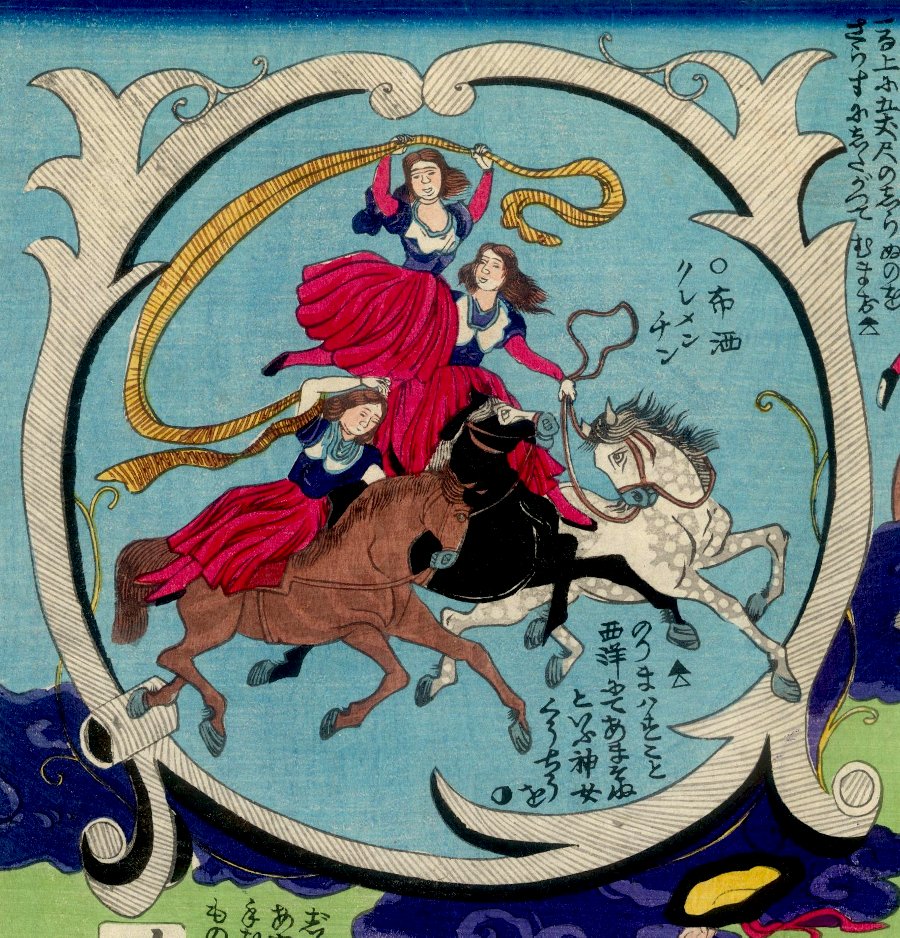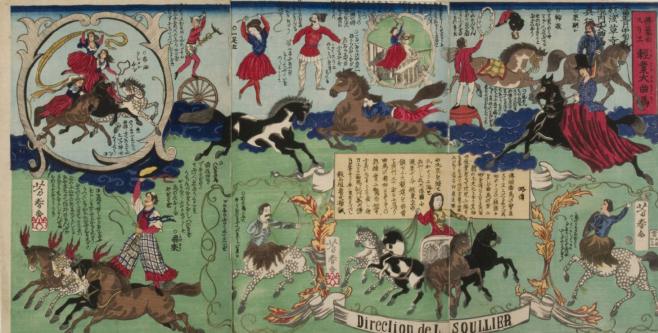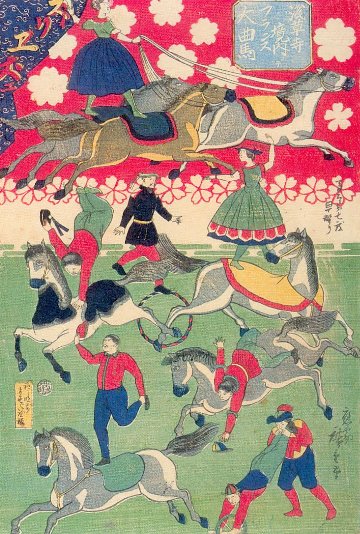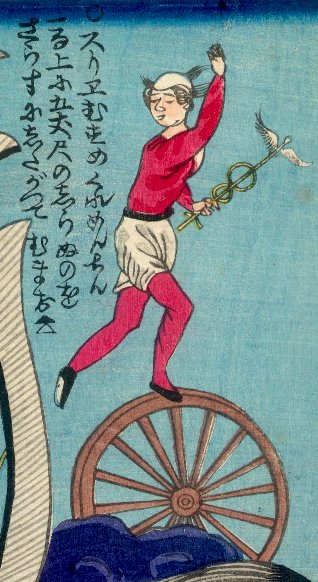
JAPANESE PRINTS
A MILLION QUESTIONS
TWO MILLION MYSTERIES
Ukiyo-e Prints浮世絵版画 |
|
formerly Port Townsend, Washington now Kansas City, Missouri |
|
UTAGAWA YOSHIHARU 歌川芳春* 1828-1888 |
|
*According to Laurance P. Roberts in his A Dictionary of Japanese Artists: Painting, Sculpture, Ceramics, Prints, Lacquer (1976 edition, p. 202) there are two variants of the haru character --- 晴 and 春. The second one appears on this print from 1871 and the other one on a print from ca. 1854. |
|
Subject: A Western Style Circus (曲馬 or きょくば) |
|
Size: 14 5/8" x 10 1/4" |
|
Publisher: Unknown |
|
Date: 1871 |
|
This is only one panel from a triptych. |
|
Signature: Yoshiharu ga |
|
署名: 芳春画 |
|
There is another copy of this print in the collection of the Ruth Chandler Williamson Gallery at Scripps College.
See below.
|
|
SOLD! THANKS D! |
|
|
|
|
|
|
|
|
|
|
|
|
|
曲馬 |
|
曲芸 |
|
|
Equestrian feats |
|
Acrobatics |
曲馬団 |
|
きょくば |
|
きょくげい |
Circus troupe |
|
|
曲馬師 |
|
きょくばだん |
|
|
Stunt rider at a circus |
|
|
|
|
きょくばし |
曲技 |
|
|
|
|
Acrobatic feats |
|
| きょくぎ | |||
|
Yoshiharu must have been very impressed by this circus because we know of one other triptych by him of a similar scene from the same year as the print featured on this page. One of our contributor/correspondents, E., confirmed this by sending us an image of a circus triptych by Yoshiharu dated from the same year. Thanks E! |
|
THE CIRCUS IS IN TOWN! THE CIRCUS IS IN TOWN! |
|
|
|
Above is one panel of a triptych by Shigemasu illustrating a performance by the French circus troupe. (This print is not for sale.)
|
|
I am old enough to remember somewhat how important it was for the Barnum and Bailey Circus to visit the regional towns and cities of the Midwest. There was a time when they traveled by rail and included fantastically decorated railroad cars custom built for them. The tops of the cars --- especially the ones carrying the animals --- looked liked the garishly carved and colored calliopes which which they used to pound out their harsh music. It wasn't Beethoven or Mozart, but it was music to the ears of children and parents alike. And long after the circus had moved on, long after the peanut shells, sawdust and elephant manure had been removed there were those old ripped and torn posters plastering wooden fences everywhere proclaiming that "The Circus is Coming!"
So, you can imagine that if I still have infantile memories of such things, then just think how much more impressive and exotic it must have seemed to the nineteenth century Japanese who were just coming out of their centuries of almost total isolation. Julia Meech-Pekarik tells us that the Cirque Soullier opened on the night of August 8, 1871 in Yokohama. The sixty-two year old M. Soullier had brought to Japan something it had never seen before. Sure, there had been native born acrobats and dare-devil horsemen, but nothing as exotic as this. One report said that the horses did everything but talk. "In early December the troupe obtained permission to visit Tokyo and performed on the grounds of the Shōkonsha (Yasakuni Shrine), attracting the attention of several artists."* That may be an understatement. |
|
|
|
There is a very informative page on the Internet about the history of circus acts in Japan from the National Museum of Japanese History entitled "The Dawn of Circus - Acrobats travel overseas". Composed by Kouichi Matsuo of the Folklore and Folklife Department he notes that one enterprising native named Hayatake Torakichi led a troupe which specialized in an act known as "kyokuzashi" (曲技し) where Torakichi performed a grand feat of strength and balance. Torakichi would support other performers atop long bamboo poles placed on his shoulders.
Almost eight years before Soullier took his troupe of bareback riders and performers to Japan an American named Richard Risley arrived with his ten artists and eight horses. However, their success was somewhat limited by their confinement to Yokohama. Then in 1866 Risley organized a visit to the West of Japanese acrobats and conjurers from several different troupes each of which seemed to have its own specialities. In the U.S. he billed them as "The Japan Imperial Artistes' Company". From there they went to Europe. This is said to have been the first time a large group of Japanese were given permission to make an extended visit overseas.
Other Japanese circus acts applied for and got permission to follow Risley group. In fact, when two different groups both found themselves in New York at the same naturally there was a degree of fraternization. We have all heard or been warned about circus performers and about their 'fraternization'. As a consequence of their encounter the first Japanese baby in the modern age was born abroad nine months later in London. Shocking!
Risley opened the door and other Westerners walked through it. Soullier was followed in 1887 by Chiarini's Italian circus which added the element of wild animals. By the 1910s even airplanes had been added to the acts. Perhaps this is the reason we refer to such aerial performances as acrobatics. If you cut and paste the kanji characters 曲技 and search Google - Images most of pictures are of planes performing death defying dives and rolls and turns, ect. |
|
|
|
*The World of the Meiji Print: Impressions of a New Civilization, by Julia Meech-Pekarik, published by Weatherhill, 1986, p. 1871. |
|
MERCURY RISING |
|
|
|
|
|
|
|
WHAT IS WITH THIS GUY? |
|
|
|
DON'T TRY THIS AT HOME! |
||
 |
||



 HOME
HOME